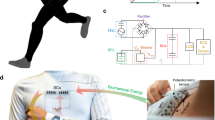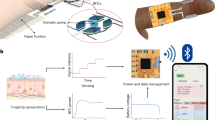Abstract
Wearable technology has the potential to advance health monitoring by enabling continuous, multimodal sensing. A major bottleneck that hampers the adoption of such advanced health monitoring systems is the need for continuous power supply. Integrated energy-autonomous wearable microgrids offer a compelling solution to support the growing power demands of long-term health care and wellness monitoring. However, wearable microgrid systems require optimal energy management, tailored to changing environmental conditions and dynamic user demands. This Perspective highlights the transformative role of artificial intelligence (AI) in optimizing and guiding the development of powerful wearable microgrids. Leveraging intelligent, accurate prediction of future energy needs, AI empowers autonomous, on-demand, continuous power supply, able to dynamically adapt to fluctuating energy needs in diverse everyday scenarios. AI’s key roles in guiding wearable microgrids include data processing, energy budgeting, sustainable energy harvesting and tailoring systems to behavioural patterns and environmental factors. The developmental trends of AI-enabled wearable microgrids are categorized into three proposed generations, with an in-depth analysis of their advanced functions and intelligent operations. The resulting microgrids balance in real-time energy production, storage and demand to achieve greater efficiency, autonomy and sustained performance, as desired for supporting continuous health monitoring.
This is a preview of subscription content, access via your institution
Access options
Subscribe to this journal
Receive 12 digital issues and online access to articles
$119.00 per year
only $9.92 per issue
Buy this article
- Purchase on SpringerLink
- Instant access to full article PDF
Prices may be subject to local taxes which are calculated during checkout



Similar content being viewed by others
References
Ray, T. R. et al. Bio-integrated wearable systems: a comprehensive review. Chem. Rev. 119, 5461–5533 (2019).
Kim, J., Campbell, A. S., de Ávila, B. E.-F. & Wang, J. Wearable biosensors for healthcare monitoring. Nat. Biotechnol. 37, 389–406 (2019).
Sempionatto, J. R., Lasalde-Ramírez, J. A., Mahato, K., Wang, J. & Gao, W. Wearable chemical sensors for biomarker discovery in the omics era. Nat. Rev. Chem. 6, 899–915 (2022).
Ates, H. C. et al. End-to-end design of wearable sensors. Nat. Rev. Mater. 7, 887–907 (2022).
Yin, L. et al. A stretchable epidermal sweat sensing platform with an integrated printed battery and electrochromic display. Nat. Electron. 5, 694–705 (2022).
Chen, C., Ding, S. & Wang, J. Digital health for aging populations. Nat. Med. 29, 1623–1630 (2023).
Yin, L., Kim, K. N., Trifonov, A., Podhajny, T. & Wang, J. Designing wearable microgrids: towards autonomous sustainable on-body energy management. Energy Environ. Sci. 15, 82–101 (2022).
Ding, S. et al. A fingertip-wearable microgrid system for autonomous energy management and metabolic monitoring. Nat. Electron. 7, 788–799 (2024).
Min, J. et al. An autonomous wearable biosensor powered by a perovskite solar cell. Nat. Electron. 6, 630–641 (2023).
Yu, Y. et al. Biofuel-powered soft electronic skin with multiplexed and wireless sensing for human–machine interfaces. Sci. Robot. 5, eaaz7946 (2020).
Yin, L. et al. A self-sustainable wearable multi-modular E-textile bioenergy microgrid system. Nat. Commun. 12, 1542 (2021).
Song, Y. et al. Wireless battery-free wearable sweat sensor powered by human motion. Sci. Adv. 6, eaay9842 (2020).
Conti, S. A self-powered integrated fingertip-microgrid sensing system. Nat. Rev. Electr. Eng. 1, 637–637 (2024).
Xu, C., Solomon, S. A. & Gao, W. Artificial intelligence-powered electronic skin. Nat. Mach. Intell. 5, 1344–1355 (2023).
Yang, P., Wei, G., Liu, A., Huo, F. & Zhang, Z. A review of sampling, energy supply and intelligent monitoring for long-term sweat sensors. npjFlex. Electron. 6, 33 (2022).
Bayoumy, K. et al. Smart wearable devices in cardiovascular care: where we are and how to move forward. Nat. Rev. Cardiol. 18, 581–599 (2021).
Lin, M. et al. A fully integrated wearable ultrasound system to monitor deep tissues in moving subjects. Nat. Biotechnol. 42, 448–457 (2024).
Zhang, Q., Zeng, X., Hu, W. & Zhou, D. A machine learning-empowered system for long-term motion-tolerant wearable monitoring of blood pressure and heart rate with ear-ECG/PPG. IEEE Access. 5, 10547–10561 (2017).
Sadasivuni, S., Saha, M., Bhatia, N., Banerjee, I. & Sanyal, A. Fusion of fully integrated analog machine learning classifier with electronic medical records for real-time prediction of sepsis onset. Sci. Rep. 12, 5711 (2022).
Gedam, S., Dutta, S. & Jha, R. Analyzing mental stress in Indian students through advanced machine learning and wearable technologies. Sci. Rep. 15, 20610 (2025).
Alghieth, M. DeepECG-Net: a hybrid transformer-based deep learning model for real-time ECG anomaly detection. Sci. Rep. 15, 20714 (2025).
Shafiq, M. et al. Dual smart sensor data-based deep learning network for premature infant hypoglycemia detection. Sci. Rep. 15, 23442 (2025).
Hu, H. et al. A wearable cardiac ultrasound imager. Nature 613, 667–675 (2023).
Zhang, J. et al. Explainable deep learning-assisted self-calibrating colorimetric patches for in situ sweat analysis. Anal. Chem. 96, 1205–1213 (2024).
Xu, M. et al. DeepWear: adaptive local offloading for on-wearable deep learning. IEEE Trans. Mob. Comput. 19, 314–330 (2019).
Zhang, T. et al. A joint deep learning and internet of medical things driven framework for elderly patients. IEEE Access. 8, 75822–75832 (2020).
Zawish, M., Ashraf, N., Ansari, R. I. & Davy, S. Energy-aware AI-driven framework for edge-computing-based IoT applications. IEEE Internet Things J. 10, 5013–5023 (2023).
Basaklar, T., Tuncel, Y. & Ogras, U. Y. tinyMAN: lightweight energy manager using reinforcement learning for energy harvesting wearable IoT devices. Preprint at https://doi.org/10.48550/arXiv.2202.09297 (2022).
Hu, B., Isaac, M., Majeed, A. P. P. A. & Liu, H. Edge intelligence-based E-health wireless sensor network systems. In 23rd International Conference on Computer and Information Science 55–59 (IEEE, 2023).
Luna-Perejón, F., Domínguez-Morales, M. J. & Civit-Balcells, A. Wearable fall detector using recurrent neural networks. Sensors 19, 4885 (2019).
Torti, E. et al. Embedding recurrent neural networks in wearable systems for real-time fall detection. Microprocess. Microsyst. 71, 102895 (2019).
Ma, Z., Mei, G. & Piccialli, F. An attention-based cycle-consistent generative adversarial network for IoT data generation and its application in smart energy systems. IEEE Trans. Industr. Inform. 19, 6170–6181 (2023).
Xiao, Z. Generative adversarial network and its application in energy internet. Math. Probl. Eng. 2022, 9985522 (2022).
AlSaad, R. et al. Multimodal large language models in health care: applications, challenges, and future outlook. J. Med. Internet Res. 26, e59505 (2024).
Subramanian, A., Yang, Z., Azimi, I. & Rahmani, A. M. Graph-augmented LLMs for personalized health insights: a case study in sleep analysis. In 20th International Conference on Body Sensor Networks 1–4 (IEEE, 2024).
Tao, P., Ma, H., Li, C. & Liu, L. Intelligent grid load forecasting based on BERT network model in low-carbon economy. Front. Energy Res. 11, 1197024 (2023).
Yuan, J. et al. A kernel-based real-time adaptive dynamic programming method for economic household energy systems. IEEE Trans. Industr. Inform. 19, 2374–2384 (2023).
Yue, Z., Witzig, C. R., Jorde, D. & Jacobsen, H.-A. BERT4NILM: a bidirectional transformer model for non-intrusive load monitoring. In Proc. 5th International Workshop on Non-Intrusive Load Monitoring 89–93 (ACM, 2020).
Çavdar, İ. H. & Feryad, V. Efficient design of energy disaggregation model with BERT-NILM trained by AdaX optimization method for smart grid. Energies 14, 4649 (2021).
Kang, M., Shin, H., Kim, J. & Kim, L.-S. MGen: a framework for energy-efficient in-ReRAM acceleration of multi-task BERT. IEEE Trans. Comput. 72, 3140–3152 (2023).
Ielmini, D. & Wong, H. S. P. In-memory computing with resistive switching devices. Nat. Electron. 1, 333–343 (2018).
Wang, Z. et al. Resistive switching materials for information processing. Nat. Rev. Mater. 5, 173–195 (2020).
Khwa, W.-S. et al. A mixed-precision memristor and SRAM compute-in-memory AI processor. Nature 639, 617–623 (2025).
Lattanzi, E., Donati, M. & Freschi, V. Exploring artificial neural networks efficiency in tiny wearable devices for human activity recognition. Sensors 22, 2637 (2022).
Bandodkar, A. J. et al. Soft, stretchable, high power density electronic skin-based biofuel cells for scavenging energy from human sweat. Energy Environ. Sci. 10, 1581–1589 (2017).
Valdés-Ramírez, G. et al. Microneedle-based self-powered glucose sensor. Electrochem. Commun. 47, 58–62 (2014).
Niu, S., Wang, X., Yi, F., Zhou, Y. S. & Wang, Z. L. A universal self-charging system driven by random biomechanical energy for sustainable operation of mobile electronics. Nat. Commun. 6, 8975 (2015).
Wang, D., Yuan, G., Hao, G. & Wang, Y. All-inorganic flexible piezoelectric energy harvester enabled by two-dimensional mica. Nano Energy 43, 351–358 (2018).
Zhao, X. et al. Soft fibers with magnetoelasticity for wearable electronics. Nat. Commun. 12, 6755 (2021).
Kim, M. H. et al. Thermoelectric energy harvesting electronic skin (e-skin) patch with reconfigurable carbon nanotube clays. Nano Energy 87, 106156 (2021).
Saifi, S. et al. An ultraflexible energy harvesting-storage system for wearable applications. Nat. Commun. 15, 6546 (2024).
Lv, J. et al. Sweat-based wearable energy harvesting-storage hybrid textile devices. Energy Environ. Sci. 11, 3431–3442 (2018).
Ye, L. et al. A rechargeable calcium–oxygen battery that operates at room temperature. Nature 626, 313–318 (2024).
Kaveti, R. et al. Water-powered, electronics-free dressings that electrically stimulate wounds for rapid wound closure. Sci. Adv. 10, eado7538 (2024).
Kumar, R. et al. All-printed, stretchable Zn-Ag2O rechargeable battery via hyperelastic binder for self-powering wearable electronics. Adv. Energy Mater. 7, 1602096 (2017).
Yin, L. et al. High performance printed AgO–Zn rechargeable battery for flexible electronics. Joule 5, 228–248 (2021).
Yin, L. et al. Wearable E-skin microgrid with battery-based, self-regulated bioenergy module for epidermal sweat sensing. Adv. Energy Mater. 13, 2203418 (2023).
Park, S.-O. et al. Phase-change memory via a phase-changeable self-confined nano-filament. Nature 628, 293–298 (2024).
Lee, D. et al. In-sensor image memorization and encoding via optical neurons for bio-stimulus domain reduction toward visual cognitive processing. Nat. Commun. 13, 5223 (2022).
Chaudhuri, T., Zhai, D., Soh, Y. C., Li, H. & Xie, L. Random forest based thermal comfort prediction from gender-specific physiological parameters using wearable sensing technology. Energy Build. 166, 391–406 (2018).
Javeed, M., Jalal, A. & Kim, K. Wearable sensors based exertion recognition using statistical features and random forest for physical healthcare monitoring. In International Bhurban Conference on Applied Sciences and Technologies 512–517 (IEEE, 2021).
Phan, D. et al. A random forest approach for quantifying gait ataxia with truncal and peripheral measurements using multiple wearable sensors. IEEE Sens. J. 20, 723–734 (2020).
Jeppesen, J., Christensen, J., Johansen, P. & Beniczky, S. Personalized seizure detection using logistic regression machine learning based on wearable ECG-monitoring device. Seizure Eur. J. Epilep. 107, 155–161 (2023).
Lee, W., Lin, K.-Y., Johnson, P. W. & Seto, E. Y. Selection of wearable sensor measurements for monitoring and managing entry-level construction worker fatigue: a logistic regression approach. Eng. Const. Arch. Manage. 29, 2905–2923 (2022).
Sathyanarayana, A. et al. Sleep quality prediction from wearable data using deep learning. JMU 4, e6562 (2016).
Aziz, O. et al. Validation of accuracy of SVM-based fall detection system using real-world fall and non-fall datasets. PLoS ONE 12, e0180318 (2017).
Doukas, C., Maglogiannis, I., Tragas, P., Liapis, D. & Yovanof, G. Patient fall detection using support vector machines. In Artificial Intelligence and Innovations 2007: From Theory to Applications (eds Boukis, C. et al.) 147–156 (Springer, 2007).
Zhang, T., Wang, J., Xu, L. & Liu, P. Fall detection by wearable sensor and one-class SVM algorithm. In Intelligent Computing in Signal Processing and Pattern Recognition (eds Huang, D.-S. et al.) 858–863 (Springer, 2006).
Gedam, S. & Paul, S. A review on mental stress detection using wearable sensors and machine learning techniques. IEEE Access. 9, 84045–84066 (2021).
Attal, F. et al. Physical human activity recognition using wearable sensors. Sensors 15, 31314–31338 (2015).
Al-Qaness, M. A., Dahou, A., Abd Elaziz, M. & Helmi, A. Multi-ResAtt: multilevel residual network with attention for human activity recognition using wearable sensors. IEEE Trans. Ind. Inform. 19, 144–152 (2022).
Shen, Q. et al. Multitask residual shrinkage convolutional neural network for sleep apnea detection based on wearable bracelet photoplethysmography. IEEE Internet Things J. 9, 25207–25222 (2022).
Li, C. et al. k-nearest-neighbour based numerical hand posture recognition using a smart textile glove. In Proc. 5th International Conference on Ambient Computing, Applications, Services and Technologies 19–24 (IARIA, 2015).
Rattanasak, A. et al. Real-time gait phase detection using wearable sensors for transtibial prosthesis based on a kNN algorithm. Sensors 22, 4242 (2022).
Bhalodia, R., Lee, I. & Elhabian, S. dpVAEs: fixing sample generation for regularized VAEs. In Proc. Asian Conference on Computer Vision (Springer, 2020).
Vaswani, A. et al. Attention is all you need. Adv. Neural Inf. Process. Syst. 30, 6000–6010 (2017).
Acknowledgements
This work was supported by the University of California, San Diego Center for Wearable Sensors (CWS).
Author information
Authors and Affiliations
Contributions
S.D., Y.B., S.X. and J.W. substantially contributed to the discussion of the content. S.D., Y.B., M.I.K., S.X. and J.W. wrote the manuscript. All the authors reviewed and edited the manuscript before submission.
Corresponding authors
Ethics declarations
Competing interests
The authors declare no competing interests.
Peer review
Peer review information
Nature Reviews Electrical Engineering thanks Wei Gao, Chi Hwan Lee and the other, anonymous, reviewer(s) for their contribution to the peer review of this work.
Additional information
Publisher’s note Springer Nature remains neutral with regard to jurisdictional claims in published maps and institutional affiliations.
Rights and permissions
Springer Nature or its licensor (e.g. a society or other partner) holds exclusive rights to this article under a publishing agreement with the author(s) or other rightsholder(s); author self-archiving of the accepted manuscript version of this article is solely governed by the terms of such publishing agreement and applicable law.
About this article
Cite this article
Ding, S., Bian, Y., Saha, T. et al. Artificial intelligence-enabled wearable microgrids for self-sustained energy management. Nat Rev Electr Eng 2, 683–693 (2025). https://doi.org/10.1038/s44287-025-00206-1
Accepted:
Published:
Issue date:
DOI: https://doi.org/10.1038/s44287-025-00206-1



